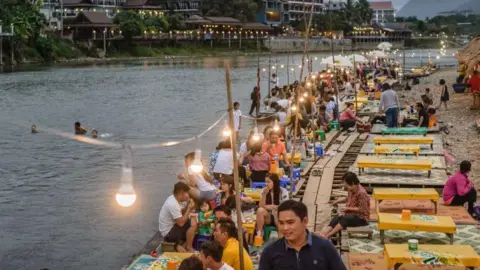Methanol poisoning deaths highlight SE Asia’s fake alcohol problem

 Getty Images
Getty ImagesSuspected methanol poisoning from contaminated drinks has reportedly killed five tourists in a Laos holiday town over the past two nights.
A British woman, an Australian woman, an American man and two Danes diedwhile another Australian woman is seriously ill in hospital. The deaths are still under investigation by police, but news reports and online testimony from other guests suggest they may have drunk drinks laced with methanol, a deadly substance often found in bootleg alcohol.
Methanol poisoning has long been a known issue throughout Southeast Asia, especially in poor countries along the Mekong River.
But despite foreign governments issuing warnings about alcohol consumption in these areas, there is still little awareness among the backpacker party scene.
Tasteless and colorless, methanol is difficult to detect in beverages and victims often do not immediately notice signs of poisoning.
And in countries like Laos – one of the poorest and least developed areas in Asia – the problem is caused by alcohol suppliers who exploit an environment where there is little regulation and almost no regulation in the food and hospitality industries.
What is methanol poisoning?
Methanol is a toxic alcohol used in industrial and household products such as paint thinners, antifreeze, varnish and photocopier fluid.
It is colorless and smells like ethyl alcohol – a chemical found in alcoholic beverages.
But methanol is dangerous to humans and drinking just 25ml of it can be dangerous.
It can take up to 24 hours for victims to start showing symptoms of illness including: nausea, vomiting and abdominal pain which can progress to hyperventilation and breathing problems.
If untreated, mortality rates are often reported to be 20% to 40%, depending on the concentration of methanol and the amount ingested, said the international medical organization Medicines Sans Frontiers (MSF) which tracks the number of disease outbreaks around the world.
But if the poison is found quickly enough, within the first 30 hours, treatment can reduce some of the worst side effects.
How common is the problem in South-East Asia?
Asia has the highest level of methanol poisoning in the world, according to the MSF website.
It is a problem that often affects poor countries – outbreaks are common in Indonesia, India, Cambodia, Vietnam and the Philippines.
Indonesia is considered a hotspot – it has reported the highest number of cases in the last two decades, according to MSFespecially in the widespread production and consumption of bootleg alcohol.
Cities like Vang Vieng in Laos, where the fatal poisoning occurred, are known to be stopovers packing route through South East Asia. The city’s economy is built on tourism, with streets lined with bars, restaurants and hostels catering to tourists.
But in Laos, law enforcement is under-resourced and there are few laws regarding food and alcohol. There is also an industry of home-brewed alcohol, which can lead to accidental poisoning.
Manufacturers also make fake drinks by making products with methanol instead of ethanol because it is cheaper, said local observers.
“You have an unscrupulous producer adding methanol to their drinks because it’s cheap – it’s used to create a drink that looks strong or to make low-quality alcoholic drinks look strong,” one Western diplomat in the region told the BBC. They also said that methanol poisoning is reported to be found in consulates throughout the region.
However, a lack of data means it is difficult to quantify the scale of contamination, and where contaminated drinks enter the supply chain.
“I don’t think the bar owners are trying to poison the guests – that’s not good for them either,” the spokesman said.
“It’s more about the manufacturing side – there’s low education, low standards, people cutting corners.”
What can be done about it?
The embassy also said that the dangers of alcohol are well known among tourism workers and embassies, but a high-level campaign is needed to inform tourists.
“This horrible event will probably help educate people, but not solve the cause of the problem,” they added.
Several Western governments have updated their advice on the dangers of alcohol in South-East Asia on their consulate and travel pages this week.
Some campaigners have called attention to accidents before. Australian man Colin Ahearn runs a Facebook page called ‘Do not drink Spirits in Bali‘ when he warns against mixed drinks such as cocktails or drinks made from open spirit bottles.
He told Australian media earlier this week that his page used to get a presentation a week about methanol poisoning across Southeast Asia.
Addressing this, a western spokesman told the BBC that it would be difficult for people to protect themselves unless they went on holiday altogether, as it would be unreasonable for tourists to look at the source of all the alcoholic beverages.
Source link



